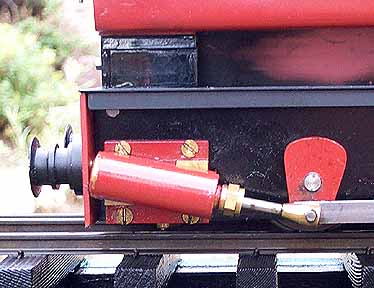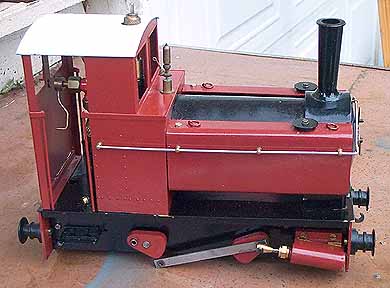
Back to Sidestreet Bannerworks
September 2003
Graham Stowell's freelance 0-4-0T
by Marc Horovitz

Graham Stowell of England is one of the most prolific and creative builders around today. His copious production and unbounded wackiness never ceases to amaze. I once had the privilege of being allowed to poke my head into his attic. There I saw dozens and dozens of engines in various states of completion, in an astounding array of configurations, made of whatever bits and parts were available at the time. It was a wonderful and daunting experience.
The engine discussed here is one of Mr. Stowell's more sedate creations. It is a simple 0-4-0T with oscillating cylinders. The cylinders are commercial products. I'm not sure who made them -- quite possibly I.P. Engineering. The boiler is a simple pot of largish diameter, fired by a meths burner housed in a shielded firebox. The burner has four wick tubes, but one is blanked off. The burner is filled through a tube in the cab and is fitted with a standard overflow.
Also in the cab is a regulator, the safety valve, a pressure gauge, and a level plug on the backhead. A reversing lever is to the left of the boiler. This controls, through a linkage, a rotary reversing valve between the cylinders that reverses admission and exhaust, which is standard on oscillating locomotives. This one is one of those funny levers that must be pushed forward to make the engine travel in reverse, and vice-versa.
The sheet-metal work is neatly done. It is screwed together, with a few dummy rivets thrown in for good measure. Siderods are no more than metal strips, square on the ends. The wheels are nice, spoked, iron castings. It's too bad that they can't really be seen inside the frames.
Detail is sparse, consisting of cab steps, some smokebox detail, dummy filler hatches on the water tanks as well as lifting rings (?). A dummy whistle resides in front of the cab. The engine is fitted with Archangel's nylon buffers, making it easier to handle when hot. The proportions are pleasing. The locomotive looks like a small industrial engine. Unlike most of Mr. Stowell's creations, this one has no name.
The run
The weather here today was unseasonably cool, with lots of cloud cover and rain -- a treat for us in dry Colorado. Simple engines should be simple to run, and this one is no exception. After performing the lighting-up ritual, I gave the track a wipe-down while pressure was building. Blow-off is around 25 psi, and this was quickly reached. After topping up the meths, I put the engine in gear, opened the throttle, and off it went.
I confess to a fondness for oscillating engines. When running well, they are smooth and reliable. And this engine ran very well, gliding silently down the rails, exhausting a handsome plume of steam into the cool, damp, afternoon air. The run progressed splendidly for 20 minutes or so, with the occasional top-up of fuel. Then, all of a sudden, the engine did a little dance and literally leapt from the rails. My first thought was that it struck something in the track, but then I noticed the siderod on my side was crossed. I figured a set screw in a counterweight had come loose, but when I picked the engine up, I saw that the other rod was dangling free. A drive pin had come out. After an extensive search, the errant pin was found (a 6BA screw). When it was replaced in the wheel and tightened down, I found that it bound up the side rod. The screw was too short by one or two threads and had to be loose to start with for the engine to run. Not having any replacement 6BA screws, I have located a piece of hex stock from which to make a new screw, so now I'm off to the workshop.
.
|
|
|
| Builder | Graham Stowell (England) |
| Date built | Early 1990s |
| Gauge | Nº 0 (32mm) |
| Scale | 16mm = 1' |
| Boiler | Pot |
| Fittings | Throttle, safety valve, level plug, pressure gauge |
| Fuel | Alcohol |
| Blow-off pressure | 25 psi |
| Cylinders | Two, double-acting oscillators |
| Reversing gear | Rotary valve controlled from cab |
| Lubricator | Displacement |
| Dimensions | 8-1/8" long over end beams, 3-1/2" wide, 6-3/8" tall |



Above: Commercial oscillating cylinders provide the power.


Right: The cab interior. The pressure gauge and throttle valve can be seen. The tube coming up from the floor is the filler tube for fuel. At the left, the reversing lever can just be seen. A dummy whistle adorns the front of the cab. Siderods are just squared-off steel strips.


Above: End of the run. The screw retaining the siderod to the crankpin has been cast off by the engine, resulting in a dropped rod that derailed the loco. The missing screw was subsequently recovered and replaced.
Back to Sidestreet Bannerworks home page
This page and its contents
Copyright Sidestreet Bannerworks, 2003